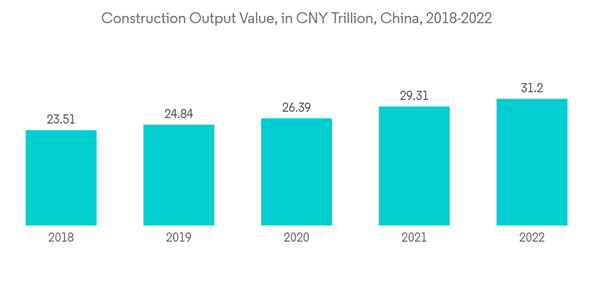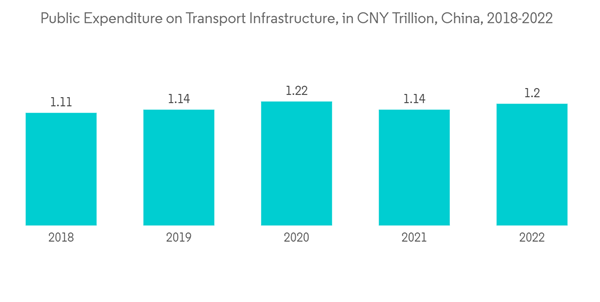The market was negatively impacted by COVID-19 since there were no construction activities during the pandemic, and the manufacturing factories were in complete shutdown. Construction industry professionals, including civil engineers, architects, and contractors, could not resume work due to the consequences of lockdowns. Currently, the market recovered from the pandemic and is growing at a significant rate.
Key Highlights
- The environmental regulations concerning the emissions from the cement industry and increasing investments in the construction industry are major factors driving the studied market's growth.
- However, the lack of awareness of the benefits of geopolymer will likely restrain the studied market's growth.
- Nevertheless, effectively utilizing industrial by-products/waste to manufacture geopolymer will likely create lucrative growth opportunities in the Asia-Pacific market.
- China represents the largest market over the forecast period due to the substantial scope for the demand for geopolymer-based products from the domestic construction industry.
Asia-Pacific Geopolymer Market Trends
Building Segment to Dominate the Market
- Geopolymers are extensively used in the construction of buildings. With the rapidly growing construction activities, owing to the overgrowing population in the Asia-Pacific region, large amounts of greenhouse gases are being emitted into the atmosphere causing huge environmental impacts.
- One of the growing demands for geopolymer concrete is due to the limited environmental impact during its production. It includes high compressive strength, low creep, good acid resistance, and low shrinkage.
- The Asia-Pacific construction sector is growing healthy, owing to the rising population, the increase in middle-class incomes, and rapid urbanization. The need for housing is increasing rapidly with the rapidly increasing population, especially in developing economies like China and India. It, in turn, is increasing residential construction across the region, which is further expected to drive the market for geopolymers.
- In China, residential buildings comprised the largest portion of finished development in 2022. Construction intended for housing accounted for over 67% of the completed floor space. As the economy grows, more people move from rural to urban regions, increasing the need for residential accommodation. Additionally, demand is increased for residences that are used as investment properties.
- In addition, the country includes the largest construction market. China is expected to spend nearly USD 13 trillion on buildings by 2030, creating a positive market outlook for the geopolymers market.
- According to the National Bureau of Statistics of China, in 2022, the construction output value in China peaked at around CNY 31.2 trillion (~USD 4.64 trillion).
- Furthermore, the housing authorities of Hong Kong launched several measures to push start the construction of low-cost housing. The officials aim to provide 301,000 public housing units in 10 years till 2030.
- Moreover, the Indian government is actively boosting housing construction to provide houses to about 1.3 billion people. The country will likely witness around USD 1.3 trillion of investment in housing over the next seven years, to witness the construction of 60 million new houses there. The availability of affordable housing in the country is expected to increase by around 70% by 2024.
- Additionally, in Australia, there is increasing pressure on the industrial sector during construction to utilize innovative materials that meet the requirements of ambitious architectural designs and reduce CO2 emissions.
- Thus, Australia's Nuclear Science and Technology Organisation (ANSTO) aimed to develop novel, sustainable low-CO2 geopolymer cement based on industrial glass and sand wastes, with enhanced durability and fire resistance for construction purposes.
- The rapidly growing building construction is increasing the demand for geopolymer-based products in several applications across building construction. Therefore, all such trends drove the demand for geopolymers in the Asia-Pacific region.
China to Dominate the Market
- In the Asia-Pacific region, China dominated the market share with growing construction activities and increasing demand for construction materials.
- The Chinese government also rolled out massive construction plans, which include making provisions for the movement of 250 million rural people to its new megacities over the next ten years, creating a major scope for the aggregates market in the country.
- China's 14th Five-Year Plan focuses on new infrastructure projects in energy, transportation, water systems, and urbanization. According to estimates, overall investment in new infrastructure planned during the 14th Five-Year Plan period (2021-2025) is roughly CNY 27 trillion (USD 4.2 trillion).
- Moreover, it is reported by the Ministry of Transport (MOT) that 299 new expressways and national and provincial highways, with a length of 9,645km, were started across the country since the start of 2022. The total investment of these projects is reported to hit CNY 882.6 billion (USD123 billion), as per an official of the ministry.
- According to the Ministry of Finance of the People's Republic of China, the total public expenditure on transport infrastructure in China amounted to about CNY 1.2 trillion (~USD 0.18 trillion) in 2022.
- Also, the increasing disposable income in the country triggered the growth of lavish commercial spaces like malls, hotels, offices, etc. China is one of the leading countries in shopping center construction. China includes almost 4,000 shopping centers, while 7,000 more are estimated to be open by 2025. Moreover, constructing office spaces like Wuhan Fosun Bund Center T1 in China is expected to boost the studied market. Construction work started in Q3 2021 and is forecasted to complete in Q4 2025.
- China is involved in several major ongoing infrastructure projects to boost the market's demand.
- For instance, Foshan Metro Line 4 Phase I, worth USD 6.98 billion, involves the construction of a 56 km metro railway line in Foshan, Guangdong. The project aims to reinforce the public transport system, providing a faster, more reliable, and environment-friendly mode of transport. Construction work started in Q1 2022 and is expected to be completed in Q4 2026.
- Further, Shanghai Metro Line 21 Phase I, worth USD 5.72 billion project, involves the construction of a 28km metro rail line between Chuansha Road Station and Dongjing Road Station in Shanghai. The project aims to improve the traffic system and reduce travel distance and time in the region. Construction work commenced in Q1 2022 and is expected to be completed in Q4 2027.
- Therefore, increasing construction activities in the country, in turn, will include a positive effect on the geopolymers market in the country.
Asia-Pacific Geopolymer Industry Overview
The Asia-Pacific geopolymer market is consolidated in nature. The major players (not in any particular order) include Wagners, Kiran Geopolymer, NTPC (National Thermal Power Corporation), SLB (Schlumberger Limited), and Betolar Plc, among others.Additional Benefits:
- The market estimate (ME) sheet in Excel format
- 3 months of analyst support
This product will be delivered within 2 business days.
Table of Contents
Methodology

LOADING...










